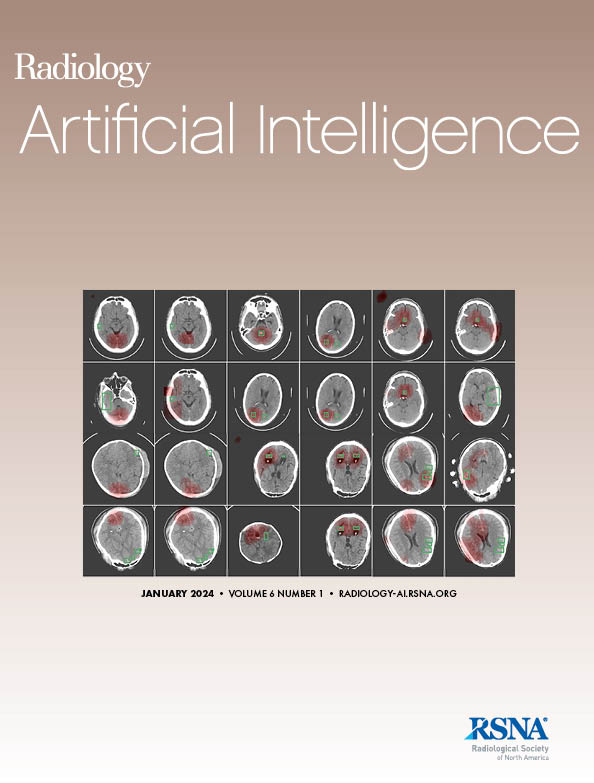Yu Fang, Honglin Xiong, Jiawei Huang, Feihong Liu, Zhenrong Shen, Xinyi Cai, Han Zhang, Qian Wang
求助PDF
{"title":"A Deep Learning Framework for Synthesizing Longitudinal Infant Brain MRI during Early Development.","authors":"Yu Fang, Honglin Xiong, Jiawei Huang, Feihong Liu, Zhenrong Shen, Xinyi Cai, Han Zhang, Qian Wang","doi":"10.1148/ryai.240708","DOIUrl":null,"url":null,"abstract":"<p><p>Purpose To develop a three-stage, age-and modality-conditioned framework to synthesize longitudinal infant brain MRI scans, and account for rapid structural and contrast changes during early brain development. Materials and Methods This retrospective study used T1- and T2-weighted MRI scans (848 scans) from 139 infants in the Baby Connectome Project, collected since September 2016. The framework models three critical image cues related: volumetric expansion, cortical folding, and myelination, predicting missing time points with age and modality as predictive factors. The method was compared with LGAN, CounterSyn, and Diffusion-based approach using peak signal-to-noise ratio (PSNR), structural similarity index measure (SSIM) and the Dice similarity coefficient (DSC). Results The framework was trained on 119 participants (average age: 11.25 ± 6.16 months, 60 female, 59 male) and tested on 20 (average age: 12.98 ± 6.59 months, 11 female, 9 male). For T1-weighted images, PSNRs were 25.44 ± 1.95 and 26.93 ± 2.50 for forward and backward MRI synthesis, and SSIMs of 0.87 ± 0.03 and 0.90 ± 0.02. For T2-weighted images, PSNRs were 26.35 ± 2.30 and 26.40 ± 2.56, with SSIMs of 0.87 ± 0.03 and 0.89 ± 0.02, significantly outperforming competing methods (<i>P</i> < .001). The framework also excelled in tissue segmentation (<i>P</i> < .001) and cortical reconstruction, achieving DSC of 0.85 for gray matter and 0.86 for white matter, with intraclass correlation coefficients exceeding 0.8 in most cortical regions. Conclusion The proposed three-stage framework effectively synthesized age-specific infant brain MRI scans, outperforming competing methods in image quality and tissue segmentation with strong performance in cortical reconstruction, demonstrating potential for developmental modeling and longitudinal analyses. ©RSNA, 2025.</p>","PeriodicalId":29787,"journal":{"name":"Radiology-Artificial Intelligence","volume":" ","pages":"e240708"},"PeriodicalIF":13.2000,"publicationDate":"2025-09-17","publicationTypes":"Journal Article","fieldsOfStudy":null,"isOpenAccess":false,"openAccessPdf":"","citationCount":"0","resultStr":null,"platform":"Semanticscholar","paperid":null,"PeriodicalName":"Radiology-Artificial Intelligence","FirstCategoryId":"1085","ListUrlMain":"https://doi.org/10.1148/ryai.240708","RegionNum":0,"RegionCategory":null,"ArticlePicture":[],"TitleCN":null,"AbstractTextCN":null,"PMCID":null,"EPubDate":"","PubModel":"","JCR":"Q1","JCRName":"COMPUTER SCIENCE, ARTIFICIAL INTELLIGENCE","Score":null,"Total":0}
引用次数: 0
引用
批量引用
Abstract
Purpose To develop a three-stage, age-and modality-conditioned framework to synthesize longitudinal infant brain MRI scans, and account for rapid structural and contrast changes during early brain development. Materials and Methods This retrospective study used T1- and T2-weighted MRI scans (848 scans) from 139 infants in the Baby Connectome Project, collected since September 2016. The framework models three critical image cues related: volumetric expansion, cortical folding, and myelination, predicting missing time points with age and modality as predictive factors. The method was compared with LGAN, CounterSyn, and Diffusion-based approach using peak signal-to-noise ratio (PSNR), structural similarity index measure (SSIM) and the Dice similarity coefficient (DSC). Results The framework was trained on 119 participants (average age: 11.25 ± 6.16 months, 60 female, 59 male) and tested on 20 (average age: 12.98 ± 6.59 months, 11 female, 9 male). For T1-weighted images, PSNRs were 25.44 ± 1.95 and 26.93 ± 2.50 for forward and backward MRI synthesis, and SSIMs of 0.87 ± 0.03 and 0.90 ± 0.02. For T2-weighted images, PSNRs were 26.35 ± 2.30 and 26.40 ± 2.56, with SSIMs of 0.87 ± 0.03 and 0.89 ± 0.02, significantly outperforming competing methods (P < .001). The framework also excelled in tissue segmentation (P < .001) and cortical reconstruction, achieving DSC of 0.85 for gray matter and 0.86 for white matter, with intraclass correlation coefficients exceeding 0.8 in most cortical regions. Conclusion The proposed three-stage framework effectively synthesized age-specific infant brain MRI scans, outperforming competing methods in image quality and tissue segmentation with strong performance in cortical reconstruction, demonstrating potential for developmental modeling and longitudinal analyses. ©RSNA, 2025.

 求助内容:
求助内容: 应助结果提醒方式:
应助结果提醒方式:


